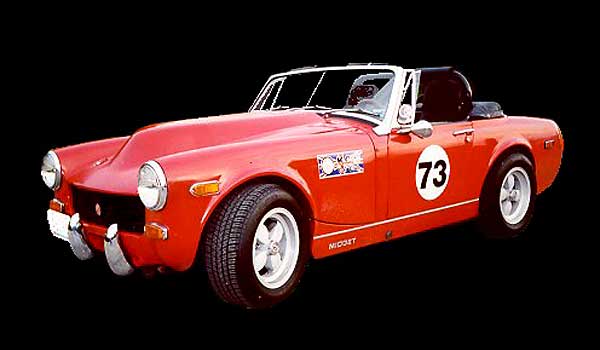
Bill Young's 1973 MG Midget with 1987 Chevy 2.8L V6 MPFI
as published in British V8 Newsletter, Volume XV Issue 1, April 2007Owner: Bill Young
BritishV8 UserID: Bill Young
City: Kansas City, MO
Conversion completed by: Bill Young at Service-Garage
"Project Half Asp"
Summary of Specs and Features| Car: | 1973 MG Midget |
| Engine: | 1987 Chevy 2.8L V6 MPFI (with all emission controls) |
| Exhaust: | custon fabricated headers and exhaust system |
| Transmission: | Borg-Warner T5 5-speed manual transmission |
| Rear Axle: | Chevy Monza (narrowed), with 3.43:1 gears |
| Front Suspension: | nylon bushings, heavy duty springs, up-rated anti-roll bar |
| Rear Suspension: | anti-tramp bars, Panhard rod, tube shocks, anti-roll bar, polyurethane bushes |
| Brakes: | front disc brakes cross-drilled and with cooling air ducted from front valance |
| Wheels: | 13x7 American "Libre" wheels |
| Tires: | 205-60R13 directional "H" speed-rated |
| Interior: | GM three-speed heater blower. Custom fabricated dashboard (with additional gauges/switches). Nissan seats with 5-point safety harness for driver. |
| Body: | relocated fuel filler with vintage racing filler cap. |
| Other: | oil cooler with custom formed air intake and oil temperature thermostat |
Project Half Asp began life as an unassuming 1973 MG Midget with original
1275cc engine and drive train. This was my second British car, the first
being a Bug Eye Sprite I bought almost 40 years before when I was a young
sailor in San Diego. That Bug Eye had a 283 Chevy stuffed in the front by
a previous owner and didn't prove to be very reliable, but loads of fun.
Unfortunately the need for a reliable car for the new wife dictated
something more mundane, so it went on to another owner.
Fast forward 37 years filled with various street rods and muscle cars to 1995
and a move to Kansas City. I needed a new toy. An MG Midget seemed just the
ticket. I drove the car for almost a year and was gradually
beginning to feel that it needed some serious performance enhancements to
be able to joust with the semi's out on the interstate when a minor traffic
accident resulted in the need for a new front clip and radiator.
The 'hot-rodder' in me took over. I decided that as long as the car was down,
now was the time for that performance boost! A lot of research and some
measurements at the local salvage yard convinced me that a GM 60 degree V6 and
5 speed transmission would fit. I also found that they'd give me the power I
wanted at about the same cost as building the 1275 and installing
a Datsun 5 speed conversion. I had owned a Fiero GT a few years before,
and I liked the performance from the GM 2.8L V6 engine.
I figure I did wind up spending a little more, but not too much and I'm
very happy with the finished product.
The name "Project Half Asp" is a play on words as well as a description
of the performance of the car. Not a Cobra or Viper, just 'half asp' and
some folks think it was a 'half a**ed' thing to do to a Midget.

The engine and transmission were from an '87 Camaro which I found at a local
auto repair shop with a lien against the car. The body was rough, but the car
ran and I was able to drive it and check out the engine and transmission.
Both seemed great. I must be lucky, I installed both without any changes
and the only failures I've had in 7 years have been a water pump and a
starter. I also replaced the timing chain. Not bad for a $950 car which
also provided the radio, speakers, engine wiring harness, computer, fuel
pump, and a variety of other small parts to the project.
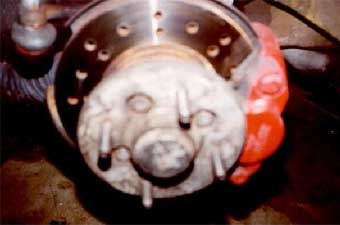 To improve braking at the front I cross drilled the stock rotors and added cooling ducting from the dust shields to the front valance. |
 |
I already had installed larger aluminum wheels on the Midget before the wreck,
so I wanted to keep the lug pattern the same. I found that the GM 10 bolt used
in the Chevy Monza and other mid 70's small cars had the same 4 x 4" pattern,
so a rear axle from a Monza was narrowed to fit the Midget.
I changed from the Monza 2.73 gears to a set of 3.43 gears from a Camaro later
on for a bit better acceleration and better rpm range at cruising speeds. The
only drawback so far is that the slightly larger bore wheel cylinders at the
rear require a bit more brake pedal travel than before so keeping up with the
adjustment is required. (Something often overlooked when swapping axles and
brakes is cylinder size)
I made my own spring mounts for the rear axle and added mounts for a Panhard
rod and rear sway bar at the same time. I did upgrade to the stiffer 1500 Midget
rear springs and used lowering blocks to set the final ride height. The rear
sway bar was created from the rear bar off of a Toyota which I heated and
reformed to fit. I then had it re-tempered by a local spring shop. Combined
with a large 7/8" front bar from a Healey, the handling is nearly neutral, tending
slightly towards understeer with oversteer available at a touch of the accelerator
pedal.

I added a tube shock conversion, using VW rear shocks, but these seem a little
harsh and the original lever action shocks would have probably served just as
well. I added traction bars below the front spring half using Midget rear spring
shackle bushings. (Using parts that were on the shelf in the garage) These allow
enough compliance to give a good ride while still retaining the axle to prevent
wheel hop.
Installing the engine and transmission proved fairly easy. A lot of time spent
measuring did pay off as there was minimal interference around the bell housing
and firewall. The transmission tunnel did require enlargement and a new rear
mount had to be formed. If you pay careful attention to the bell housing
diameter, block length from bell housing flange to end of front pulley, and
height from crank centerline to the top of the induction you will save yourself
a load of headaches in the long run. Try to pick an engine that will fit rather
than the largest thing available and then trying to modify the chassis to fit.
It's a lot more work. The 60 degree V6 will fit the Midget chassis and use the
stock steering shaft if custom headers are used.
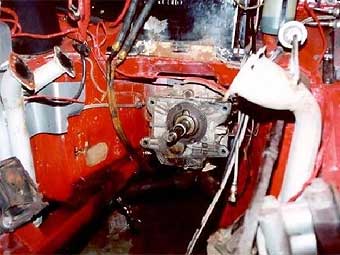

The heater air duct required some slight reshaping on the underside to clear the
bell housing and the right foot well required about a half inch dent from a hammer to
clear the starter.
The steering rack mount did have to have the center removed similar to the way
a 1500cc engine Midget mount is made. I made front motor mounts from quarter inch
steel plate and mounts from a Chevy pickup. I made an adaptor plate which bolts
to the original motor mounting points on the Midget chassis and from these mounted
the Chevy rubber mounts and block adaptors which I fabricated. These are simple
steel plate with a piece of 1" steel tubing welded between. This gave more
clearance around the sides of the engine for oil cooler lines etc.
I wanted to keep the fuel injection on this engine, so I realized that significant
modification would be required to the bonnet. I think that if you decided to use
a carb on a low profile manifold you could get by with only a small scoop on the
bonnet. The hood was modified using panels cut from an old hood I picked up at a
local swap meet. It took a bit of time to form and weld, and a lot of filler due
to my poor welding ability and warpage, but it seals out the weather and doesn't
look too bad to me. After seeing the hood on EX186, I guess I can claim some
'factory' influence.


The clutch linkage proved to be a problem at first. The original linkage protruded
from the side of the bell housing enough to interfere with the driver's side frame
rail and foot well. I was able to shorten the lever about 1" and mount the slave
cylinder push-rod through the existing bulge for a starter motor on the driver's
side that is used on other applications of this engine. I replaced the sheet metal
dust shield on the bottom of the bell housing with one made from 3/16" steel plate
and welded studs to that to mount a slave cylinder from a 1500cc Midget. This made
for a little higher clutch effort, but still not uncomfortably harsh and eliminated
any need to cut the foot well or frame.
In the Camaro and Firebird chassis the T-5 transmission is tilted at about a 17
degree angle from vertical. To make transmission tunnel mods far easier I returned
the transmission to a vertical mounting. The bosses are already cast into the bell
housing but needed drilling and tapping. I also removed any protrusions from the
transmission that were not necessary such as mounting ears for assembly line
fixtures, etc. I modified an angle drive from an MGB to take the mounting ring for
the T-5 speedometer gear and used an MGB overdrive cable to the speedometer.
The tunnel still required the top to be raised about 1.5" and the profile widened
slightly above about 2.5" from the floor pan. The shifter wound up about 3.5"
further to the rear, but is not in an uncomfortable position even for a large driver
(I stand 6'4"). I removed the original shifter and straightened the lever, shortened
and welded on a 5/16" fine thread bolt for the original MG shift knob. I reused the
mount for the shifter boot from the original tunnel and reused the original boot and
retaining ring.
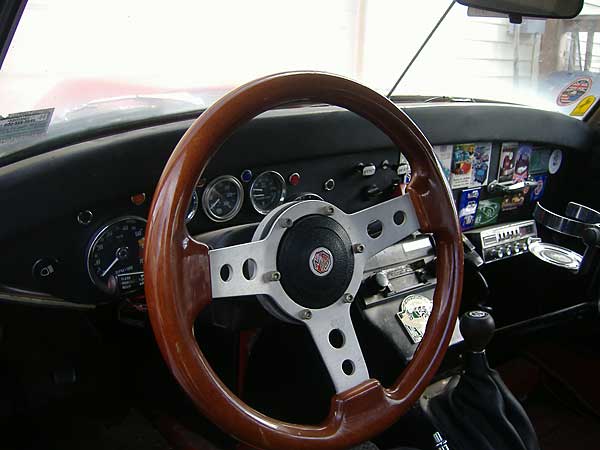
The dash uses mostly GM switchgear off of the Camaro which provided the engine.
I added an oil temp gauge and a lamp for the "service engine" indication from the
computer.
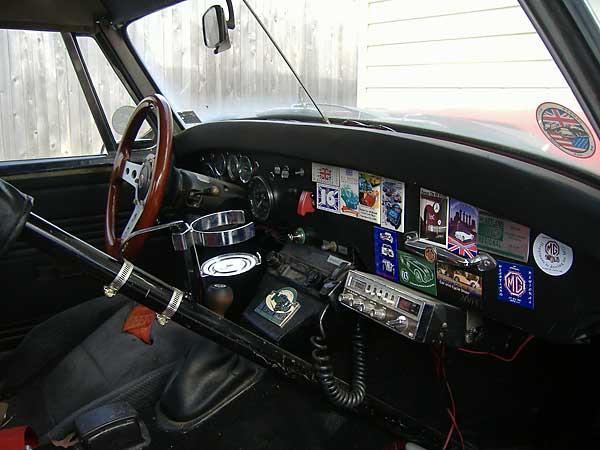
I wanted to retain the fuel injection and associated computer, so I felt that I
would have to keep all the factory emissions equipment in order for the computer
to get the correct signals. I also wanted the car to be as 'clean' as possible
to avoid any future problems with the state. In order to keep this equipment I had
to design and fabricate new mounts for the air pump and alternator.
I tried various exhaust manifolds from several applications of this engine in various
FWD and RWD chassis, but could not find one that would fit on the driver's side and
clear the steering, so I built headers from U-bends and flanges purchased from
J.C. Whitney.


The headers on each side dump into a 2.25" Y pipe where the oxygen sensor is mounted
and then to a catalytic converter then on rearward to a glass-pack muffler and Monza
exhaust tip. I did make a heat shield for the top and bottom of the catalytic
converter to both reduce heat in the passenger compartment and reduce the chance of
setting grass or leaves on fire.
The fuel injection requires a high pressure pump and a return line to the tank
for unused fuel. I modified the original tank to mount the Camaro fuel pump/pick up
assembly and return line. I reused the steel fuel and return lines from the Camaro
with some re-bending and used braze-on AN ends and AN fittings throughout the fuel
system.

For a change of style and to make the car look a little more competition-oriented,
I moved the fuel filler up to the top of the rear deck and mounted an Aston-Martin
style flip-top filler.
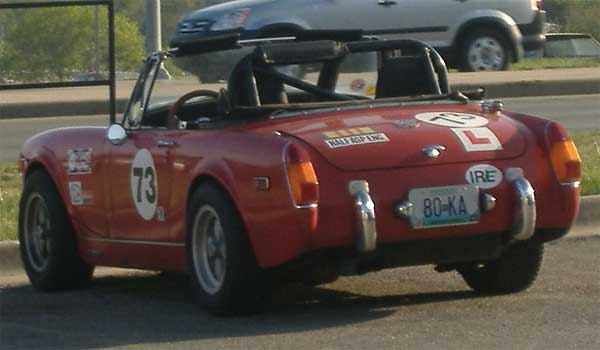
I also bent up a roll hoop with extra bracing to add to the competition flavor and
to strengthen the chassis a bit. A cross bar provides a mounting point for the
shoulder straps of the 5-point racing seat belts.

I added an oil cooler from a MGB with a thermostat using a 'sandwich' adaptor.
The original oil filter is accessible, but just barely. If I were to do this again
I'd use a remote filter mount. I also mounted an oil temperature gauge; you can see
the fitting for the sending unit in the oil pan in the photo.
The radiator came from an early MGB which I picked up at a local swap meet for
about $15. I reversed the side brackets and modified the inlet and outlet fittings
using copper plumbing fittings. I found an electric fan from a BMW at the local
salvage yard and mounted it in front of the radiator. It's controlled by a relay
and a sensor in the right cylinder head. The computer can also control the fan if
it senses an over-temp condition. I've had no cooling problems even in heavy
traffic on 90+ degree days. Since the fan will run anytime the ignition is on
and the engine temperature is high enough, I added a bypass switch which will cut
power to the fan in those circumstances to give more power to the starter.
>
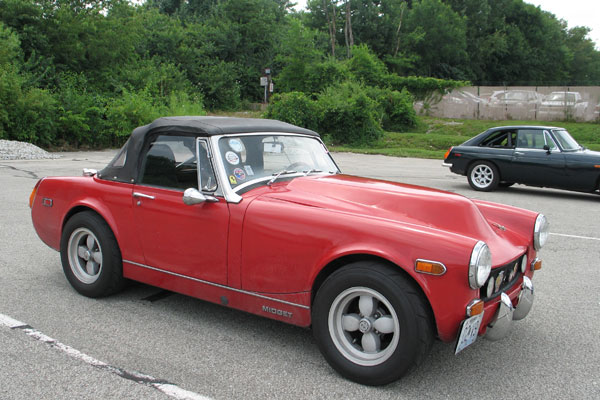

I added ducts for the oil cooler and brake vents to the valance and mounted
bumperettes from a bugeye Sprite, both front and rear, inverting them for a little
different look. A later addition was driving lights in the front grille, which
definitely aid night vision.

I've had the car on the road for 7 years now and have thoroughly enjoyed it. It's
been on one of our FAT runs (Fall Alternative Tour) which covered over 500 miles in
two days of good high speed driving on the twisty back roads of southern Missouri
and down to Oklahoma for the MG Vintage Races last year which was an 800 mile weekend
without a problem. The car is reasonably comfortable to drive for long distances
considering my size at 6'4" and 230 pounds. Ground clearance is minimal, but then
that's the same with any Midget so speed bumps are to be avoided.
As far as measured performance goes, it clocked 95 mph in a standing start 5/8 mile
at the Chanute Chute Out a couple of years ago. Fast enough for me. It cruises
effortlessly at 70-75 mph with loads of power in reserve to pass if required.
Mileage continues to average around 25mpg overall on longer trips.





